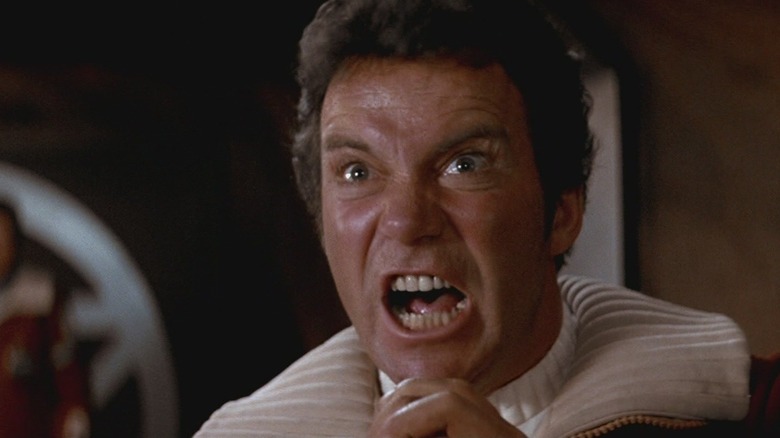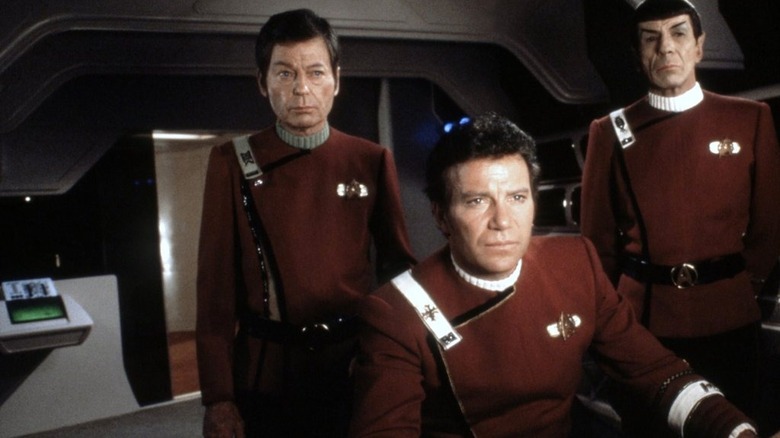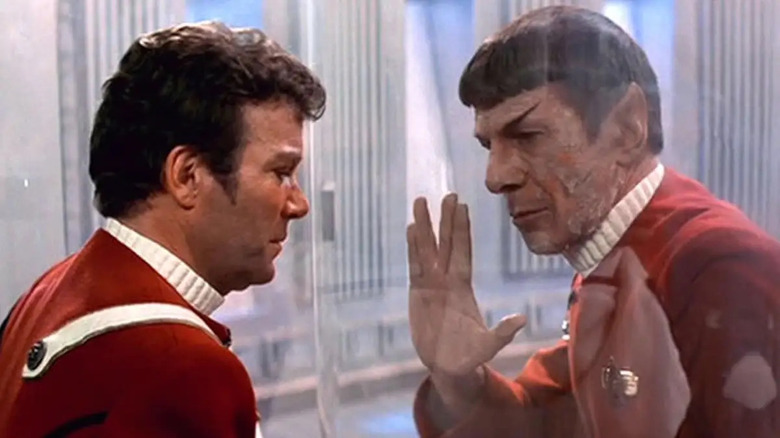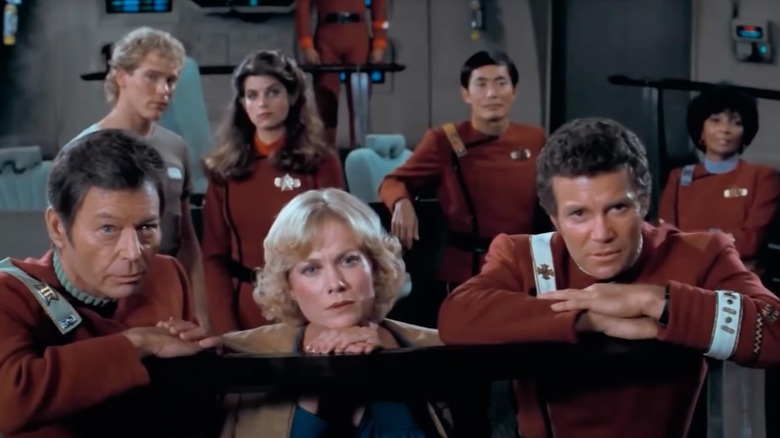Star Trek II Went Through 5 Different Scripts Before Getting To The Wrath Of Khan We Know
Most Trekkies will be able to tell you that Robert Wise's 1979 film "Star Trek: The Motion Picture" wasn't as big a success as Paramount had hoped. The film is famously slow-moving, aiming for cosmic grandeur and hefty evolutionary themes over the then-popular whizzbang action of "Star Wars." "Star Trek" creator Gene Roddenberry oversaw the production of "Motion Picture," and the overall tepid response left him in Paramount's bad graces. This was in addition to multiple delays in filming, the production going over budget, and those common studio spats so often classified as "creative differences." According to William Shatner (as he wrote in his autobiography "Star Trek Movie Memories"), Roddenberry was essentially fired from the production of any potential sequel for "Motion Picture" as a result of all the drama, and the Great Bird of the Galaxy was given the faraway and somewhat demeaning title of "executive consultant" on any future productions.
Roddenberry, of course, was already working on a "Star Trek II" before this happened, and he envisioned a complex morality play that involved time travel. In Roddenberry's initial script, a group of Klingon terrorists discover the location of the Guardian of Forever, a living time portal seen in the episode "The City on the Edge of Forever" (April 6, 1967), and travel into Earth's past to prevent the assassination of John F. Kennedy and alter Earth history to their advantage. The Enterprise crew would have to follow the Klingons into 1963 to restore the timeline.
Sadly, Roddenberry's script was rejected.
In his 2010 memoir "The View from the Bridge," Nicholas Meyer, the director of "Star Trek II: The Wrath of Khan," revealed the existence of at least five additional drafts for a potential "Star Trek II" before the final version that audiences got to see.
Character over story
After Roddenberry was ousted, production was handed over to producer Harve Bennett, who, in turn, sought out the eventual "Star Trek II" director (and uncredited screenplay contributor) Nicholas Meyer. Meyer was the one who felt that a new "Star Trek" film shouldn't be story-focused, intuiting that Trekkies were fond of the characters more than heady sci-fi scenarios. As such, he began to work out a script that was more focused on Kirk (William Shatner) and his relationships with Dr. McCoy (DeForest Kelley) and Spock (Leonard Nimoy), as well as the good Admiral having to face the failings of his past.
This basic premise, however, was an amalgam of several scripts that Bennett presented to Meyer when he was first brought on board. Meyer recalled:
"When I got involved there were five drafts of a second Star Trek movie, and one of them were related. [...] What I wound up doing after consulting with Harve and his producing partner, Robert Sallin, was to make a laundry list of the things we liked in those five scripts. Then I wrote a brand new script fiddling with those different pieces like a Rubik's Cube in order to get a coherent story."
The only common element of all five of these mysterious scripts was the death of Spock. At the end of Meyer's film, Spock sacrifices his life to repair a vital system of the U.S.S. Enterprise and allow it to best the titular wrathful Khan (Ricardo Montalbán) in battle. It seemed that Spock was going to die no matter what, so it was up to Meyer and Bennett to think of how. Meyer recalled the brainstorming process and the changes Spock's death went through.
Spock dies every time
Meyer recalled the "Eureka!" moment about Spock's death, although his initial idea doesn't match what ended up in the final script. The director recalled:
"One of the scripts had a simulator sequence of a fake disaster that appeared on page 45. I moved it to the first scene in the movie, and Spock wasn't in it. Harve and I were discussing the script one morning and I said, 'We should put him in the first scene and kill him off then.' To my astonishment, Harve said, 'That is genius!'"
Bennett and Meyer reworked the "disaster" idea into a scene of sacrifice. Spock, however, is not an emotional figure who would sacrifice himself passionately, but an emotionless character who would need a logical reason to do so. As such, Meyer thought up one of the most iconic lines in all of "Star Trek." He wrote:
"Spock's death ultimately isn't an act of sacrifice — it's lifeboat ethics. [...] If a lifeboat becomes overloaded with people then somebody is going to have to go overboard if the sea is anything but calm. Like Spock says, 'The needs of the many outweigh the needs of the few or the one.' So he decides, 'I'll save the many.'"
It was a satisfying moment.
Getting there, however, was circuitous. Some of the unused scripts for "Star Trek II" seemed pretty wild. The scripts were described in a 2002 issue of Star Trek: The Magazine, and there were stories that might have made for some pretty epic movies.
War of the Generations
When Bennett was first brought on to "Star Trek II," he immediately penned a script called "Star Trek II: War of the Generations." In that script, Kirk was called to a distant planet to quell a violent revolution, only to discover that the rebellion was being led by his long-lost son. Father and son would have to face off. Later in that same script, Khan would appear as the true manipulator of the rebellion, and Kirk and Kirk, Jr. would have to team up to take down the tyrant.
Bennett, needing help, hired Jack B. Sowards, and Sowards wrote a script called "Star Trek II: The Omega Syndrome," which would have involved a Federation super-weapon called the Omega System. Another screenwriter, Michael Minor, perhaps sensing the warlike implications of the Omega System (or perhaps just the "Star Wars"-like implications) suggested that the weapon be turned into a terraforming device called the Genesis Device, as that's more in the spirit of "Star Trek." Minor's idea made it into the final script.
In one script, Spock's death occurred very early in the story, a twist that can be compared to Janet Leigh's death in "Psycho." However, that version of the script leaked to the public and Bennett's team had to scramble to write a new draft. Samuel L. Peeples ("Where No Man Has Gone Before") was brought onto the team, and he invented the character of Saavik, originally a male, as well as new villains Sojin and Moray, powerful godlike aliens who nearly destroy Earth. Peeples cut Khan.
Meyer, not a Trekkie, was finally brought on at this point, and "Star Trek II" finally began to take shape. Khan was restored, and the film came together.
But, wow, what a twisted path that was.



